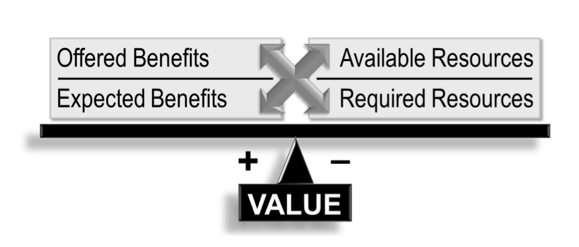Agile, programs and benefits management
This article follows on from The synergy between Agile and program management.
The PMI Standard for Program Management states: “Programs and projects deliver benefits to organizations by enhancing current capabilities or developing new capabilities for the organization to use. A benefit is an outcome of actions and behaviours that provides utility to the organization.” (PMI, 2008a).
Managing Successful Programmes, the UK Standard, defines a benefit as “the measurement of an outcome or a part of an outcome. An end benefit is a direct contribution to a strategic objective. It describes an advantage accruing from the outcome.” (OGC, 2007).
In layperson’s terms, a benefit is a positive outcome that stems out of the use of a product or capability; it is an outcome of the execution of the strategy. In program management, benefits are measured by the tangible business improvements that support the strategic objectives; not the results delivered, but their outcomes. In Agile management, benefits are measured by the performance of the solution and usefulness of the product; not its technical characteristics. In both program and Agile management, benefits are measured at operational level.
Until project results are used by the business, any project is an expenditure. Benefits can be measured only after the project result has been delivered and is being used. Benefits are typically described in functional terms, this enables the design/development team to achieve maximum flexibility for the technical or operational aspects of the product, including benefits/cost ratio, and enhance its ability to respond to changes in stakeholders’ needs and expectations.
Agile management helps deliver benefits on an ongoing basis during the course of the project by identifying and focusing on small incremental working versions of the agreed expected result. Program management helps to decompose the strategy into prioritised expected benefits and pace their delivery in an agreed manner. Both programs and Agile methods aim to deliver benefits in a controlled stream.
Efficiency and reliability are the two measures of value in a project. Have you used only the resources that were allocated to you? Typically: time and cost. Have you delivered what was expected? Typically: scope and quality. Control these four elements and your project is a success. But in order to do this, scope, quality, time and cost have to be well defined from the start, typically in the project charter. When these four elements are not well defined, you are not in project mode and should use alternative methods of management.
One of the well documented features of Agile management is its focus on capturing true user requirements; this is the essence of the ongoing stakeholder (user) involvement process. Having practiced (building) architecture for many years, I have learned that in complex projects where there are many stakeholders involved, or in projects where the results directly affect them, stakeholders, and users in particular, will change their mind about what they need. When you deliver a production facility, a road or bridge, a new piece of hardware, a training course or a new pay system, you can generally define the project quite accurately from the start. When you deliver a new computer program, an organisational change, a private home, or an infrastructure project that will challenge a community, the requirements and parameters will evolve.
In such cases, you will be in program mode if the change is of strategic level or in Agile mode if the project is of technical or operational level. The same concepts apply to both. In both cases you need to focus on benefits, not on the initially specified product. The issue with Agile, program and fast-tracking is that development occurs in parallel with delivery—this is not the case with traditional project management!
Value is the balance between the satisfaction of the needs and the resources used to achieve this satisfaction: the greater the satisfaction and the lower the resources used to satisfy them, the higher the value. In a project it translates by achieving the highest possible scope and quality within the lowest possible time and cost.
Figure 2: Using value to respond to opportunities and manage change (©Thiry, 2010)
If development occurs in parallel with implementation, the program/Agile-project team has to focus on change as opportunities rather than change as risks and use a value approach to do so. In programs and Agile projects, there will be a continual balancing act of the expected benefits and the resources required to deliver them against the available resources and the offered benefits to achieve value (see above).
Responsiveness to evolving stakeholder/user demands and stakeholder involvement is the key to success. But how can one respond to continually changing demands and still stay in control? This is where the concept of decision management comes into play.
Program and Agile Management: Two birds of a feather? series:


